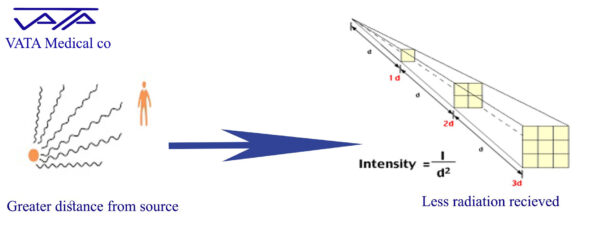


Despite the numerous benefits of X-rays in the disease diagnosis process, the need to protect against the X-Rays radiation effects on human body is also inevitable. All personnel and individuals exposed to radiation must comply with radiation protection regulations. Although it can never be claimed that radiation has been performed at zero, the dose received by individuals can be minimized by following the rules of radiation protection.
1- Exposure time: The imaging process should be done in the shortest time allowed. Low imaging time should not affect the quality of the diagnosis, but more importantly, correct diagnosis and treatment in the shortest possible time. The total dose received is calculated from the following formula:
Exposure time * Dose rate (amount of energy absorbed from all beams) = total dose received

Reduce radiation time – ALARA principle
2- Distance from the x-ray source: As the distance from the X-ray tube increases, the amount of dose received decreases relative to the square of the distance, which means that doubling the distance reduces the power of the beam by a quarter. The technician must also be aware of the placement of the tube and the proper angle for imaging during radiology. Evaluation of appropriate collimation and how radiation factors are important in limiting the patient’s radiation exposure.

Dose Reduction Technique -distance – ALARA priciple
3- Shielding: Technicians must be present in the lead-covered control room during the exposure. Lead shields are one of the most effective methods of X-ray protection if you need to be with the patient. Also, when imaging, parts of the patient’s body that do not need to be irradiated should be protected by lead shields. Lead shields are able to absorb radiation due to their high molecular weight composition. Sufficient attention should also be paid to covering areas sensitive to radiation such as the thyroid, genitals and iris due to its excessive side effects.

shielding and ALARA
The sum of the three principles of irradiation time, distance from the radiation source and the use of lead shields mentioned above, expresses the concept of the ALARA principle (As Low As Reasonably Achievable), which is approved by the Radiation Protection Commission. The radiologist should consider the principle of ALARA and, with the proper imaging technique, assist the patient in choosing the appropriate position and the correct use of exposure values, and bring the minimum dose to himself and the patient.
In general, the effects of radiation depend on the type of radiation, the amount of radiation, the age of individuals, the parts of the body that are irradiated, and the characteristics of genetic function of individuals. .